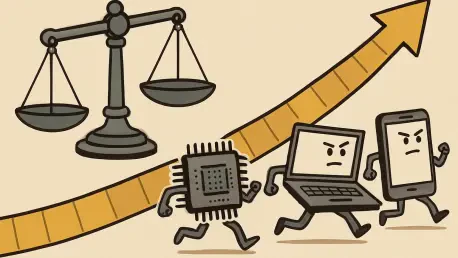In an era where technology reshapes industries overnight, a recent federal court decision involving Meta, the parent company of Facebook, Instagram, and WhatsApp, has sparked intense debate about the effectiveness of antitrust laws in dynamic markets. The U.S. District Court for the District of Columbia dismissed a long-standing lawsuit by the Federal Trade Commission (FTC) accusing Meta of monopolistic practices through its acquisitions of Instagram and WhatsApp. This ruling not only exonerates Meta but also raises profound questions about whether regulatory frameworks can adapt to the lightning-fast pace of innovation in the tech sector. As social media platforms evolve and new competitors emerge, the gap between market realities and legal enforcement seems to widen, challenging the very foundation of how monopoly power is defined and addressed. This landmark case serves as a critical lens through which to examine the intersection of law, competition, and technological advancement.
Challenges in Regulating Tech Giants
Defining the Market in a Fluid Landscape
The core issue in the FTC’s case against Meta hinged on how the market is defined, a task that becomes increasingly complex in the ever-shifting tech industry. The FTC argued for a narrow definition of “personal social networking,” encompassing platforms like Facebook, Instagram, and Snapchat, while excluding broader competitors such as YouTube and TikTok. However, Judge James Boasberg rejected this approach, ruling that Meta competes in a wider social media market where boundaries between networking and entertainment content have blurred. Empirical evidence of user behavior, such as switching between Meta’s platforms and rivals for short-form video content, supported the court’s broader perspective. This decision underscores a fundamental challenge: traditional antitrust tools often rely on static market definitions, which fail to capture the fluidity of digital ecosystems where user preferences and platform features evolve rapidly, rendering narrow categorizations obsolete almost as soon as they are established.
Speed of Innovation Versus Legal Timelines
Another significant hurdle for antitrust enforcement is the stark contrast between the rapid pace of technological innovation and the slow grind of legal processes. When Meta acquired Instagram and WhatsApp over a decade ago, the competitive landscape looked vastly different, with fewer players dominating social networking. Since then, the rise of TikTok and the expansion of YouTube into short-form content have transformed how users engage with social media. By the time the FTC’s case reached a resolution, the market dynamics it sought to address had already shifted, highlighting how legal battles spanning years struggle to remain relevant. This discrepancy suggests that regulators risk focusing on outdated issues while new competitive threats and innovations reshape the industry, leaving enforcement actions misaligned with current realities and potentially ineffective in safeguarding fair competition in fast-moving sectors like technology.
Implications for Future Antitrust Enforcement
Adapting Frameworks to Modern Realities
The outcome of Meta’s legal victory over the FTC signals a pressing need for antitrust frameworks to evolve in step with technological advancements. Judge Boasberg’s emphasis on assessing monopoly power based on the current competitive landscape, rather than historical actions, sets a precedent that could reshape how future cases are approached. This forward-looking perspective acknowledges that user behavior and platform functionalities continuously redefine market boundaries, as seen with the convergence of social networking and broader media consumption. For regulators, this means developing more flexible tools and methodologies that account for real-time data and emerging trends. Without such adaptability, enforcement risks becoming a reactive exercise, addressing past grievances while failing to tackle present or future challenges posed by tech giants whose influence spans multiple dimensions of digital interaction.
Balancing Regulation with Innovation
Equally important is the challenge of balancing stringent regulation with the need to foster innovation in the tech sector. While the FTC aimed to protect competition by scrutinizing Meta’s past acquisitions, the court’s ruling suggests that overly restrictive measures based on historical data may not reflect today’s competitive environment. This raises a critical consideration for policymakers: how to ensure fair market practices without stifling the very innovations that drive consumer benefits and industry growth. The rapid emergence of new formats like short-form video content illustrates how quickly companies adapt to user demands, often outpacing regulatory foresight. As antitrust strategies evolve, finding equilibrium between curbing monopolistic tendencies and encouraging technological progress will be paramount, ensuring that enforcement supports a dynamic market where new entrants can thrive alongside established players.
Navigating the Path Forward
Building Agile Regulatory Mechanisms
Reflecting on Meta’s triumph in court, it becomes evident that the slow machinery of antitrust law has struggled to match the swift transformations within the tech world. The decision highlighted a crucial lesson: legal systems must prioritize current market conditions over past actions to remain relevant. Moving forward, regulators might consider establishing more agile mechanisms, such as real-time monitoring of market trends and user behavior, to inform enforcement actions. Collaborations with industry experts could further enhance understanding of evolving digital landscapes, ensuring that interventions address immediate competitive concerns rather than lagging behind innovation cycles. Such steps could redefine how monopoly power is assessed, aligning legal oversight with the realities of a sector where change is the only constant.
Encouraging Proactive Policy Development
Looking back, the case also revealed that historical data alone has proven insufficient for tackling modern tech challenges. To bridge this gap, policymakers should focus on proactive policy development, anticipating future shifts in technology and market dynamics over the coming years. Initiatives like predictive modeling and scenario planning could help regulators stay ahead of the curve, crafting rules that adapt to emerging platforms and user habits. By fostering a regulatory environment that evolves alongside technology, authorities can better safeguard competition while supporting innovation, ensuring that the lessons from this pivotal ruling shape a more responsive and effective approach to antitrust enforcement in the digital age.









